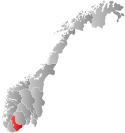Hornnes og Iveland
Hornnes og Iveland Municipality
Hornnes og Iveland herred | |
|---|---|
 Aust-Agder within Norway | |
 Hornnes og Iveland within Aust-Agder | |
| Coordinates: 58°33′33″N 07°46′24″E / 58.55917°N 7.77333°E | |
| Country | Norway |
| County | Aust-Agder |
| District | Setesdal |
| Established | 1 Jan 1838 |
| • Created as | Formannskapsdistrikt |
| Disestablished | 1 Jan 1886 |
| • Succeeded by | Hornnes and Iveland municipalities |
| Administrative centre | Hornnes |
| Area | |
• Total | 640 km2 (250 sq mi) |
| Population (1886) | |
• Total | 2,216 |
| • Density | 3.5/km2 (9.0/sq mi) |
| Demonyms | Horndøl Ivelending[3] |
| Time zone | UTC+01:00 (CET) |
| • Summer (DST) | UTC+02:00 (CEST) |
| ISO 3166 code | NO-0935[4] |
Hornnes og Iveland is a former municipality in the old Nedenæs county in Norway. The 640-square-kilometre (250 sq mi) municipality[1][2] existed from 1838 until its dissolution in 1886. It included all of the present-day municipality of Iveland and the western half of the present-day municipality of Evje og Hornnes in the Setesdal region of Agder county. The administrative centre was the village of Hornnes where the Hornnes Church is located. The other church in the municipality was the Iveland Church in the village of Birketveit.
History
[edit]The parish of Hordnæs og Iveland was established as a municipality on 1 January 1838 (see formannskapsdistrikt law). According to the 1835 census, the municipality had a population of 1,848.[5] On 1 January 1886, Hornnes og Iveland was divided to create two separate municipalities: Hornnes (population: 1,113) and Iveland (population: 1,103). The municipality of Iveland still exists today, while Hornnes currently a part of the municipality of Evje og Hornnes.[6]
Name
[edit]The two neighboring parishes of Hornnes and Iveland were put together as a single municipality after the formannskapsdistrikt law went into effect on 1 January 1838. The resulting municipality was given the compound name Hornnes og Iveland, literally meaning "Hornnes and Iveland".
The historic parish of Hornnes is named after the old Hornnes farm (Old Norse: Hornnes) since the first Hornnes Church was built there. The first element is horn which means "horn". The last element is nes which means "headland". So the meaning of Hornnes is "the headland shaped like a horn". This is likely referring to the two horn-shaped peninsulas that jut out into the river Otra at the entrance to the lake Breidflå.[7]
The historic parish of Iveland is named after the old Iveland farm (Old Norse: Ífuland) since the first Iveland Church was built there. This old farm is now part of the village of Birketveit. The first element is the genitive case of the local river name Ífa which now called the Frøysåna. The river name is probably derived from the word ýr which means "yew" (Taxus baccata). The last element is land which means "land" or "district".[8]
Government
[edit]During its existence, this municipality was governed by a municipal council of directly elected representatives. The mayor was indirectly elected by a vote of the municipal council.[9]
Mayors
[edit]The mayors (Norwegian: ordfører) of Hornnes og Iveland:[10]
- 1838-1839: Tellef Christensen Fjellestad
- 1839-1842: Thomas Sørensen Hodne
- 1842-1843: Salve Baardsen Mjaaland
- 1843-1849: Torje Jensen Aas Kjetsaa
- 1849-1851: Christen Andersen Skaiaa
- 1851-1857: Torje Jensen Aas Kjetsaa
- 1858-1863: Christen Thorkildsen Nateland
- 1863-1865: Thomas Sørensen Hodne
- 1866-1869: Christen Thorkildsen Nateland
- 1869-1871: Thomas Sørensen Hodne
- 1871-1873: Torje Jensen Aas Kjetsaa
- 1873-1877: Mads Gundersen Faret
- 1878-1879: Tellef Salvesen Eieland
- 1879-1881: John N. Hornnes
- 1882-1885: Tellef Tellefsen Frøysaa
See also
[edit]References
[edit]- ^ a b Thorsnæs, Geir, ed. (10 July 2015). "Hornnes". Store norske leksikon (in Norwegian). Kunnskapsforlaget. Retrieved 22 May 2017.
- ^ a b Thorsnæs, Geir, ed. (5 April 2016). "Iveland". Store norske leksikon (in Norwegian). Kunnskapsforlaget. Retrieved 22 May 2017.
- ^ "Navn på steder og personer: Innbyggjarnamn" (in Norwegian). Språkrådet.
- ^ Bolstad, Erik; Thorsnæs, Geir, eds. (26 January 2023). "Kommunenummer". Store norske leksikon (in Norwegian). Kunnskapsforlaget.
- ^ "Hjemmehørende folkemengde Aust-Agder 1801-1960" (in Norwegian). University of Tromsø: Registreringssentral for historiske data. Archived from the original on 10 June 2007. Retrieved 14 October 2006.
- ^ Jukvam, Dag (1999). Historisk oversikt over endringer i kommune- og fylkesinndelingen (PDF) (in Norwegian). Statistisk sentralbyrå. ISBN 9788253746845.
- ^ Rygh, Oluf (1905). Norske gaardnavne: Nedenes amt (in Norwegian) (8 ed.). Kristiania, Norge: W. C. Fabritius & sønners bogtrikkeri. p. 186.
- ^ Rygh, Oluf (1905). Norske gaardnavne: Nedenes amt (in Norwegian) (8 ed.). Kristiania, Norge: W. C. Fabritius & sønners bogtrikkeri. p. 179.
- ^ Hansen, Tore; Vabo, Signy Irene, eds. (20 September 2022). "kommunestyre". Store norske leksikon (in Norwegian). Kunnskapsforlaget. Retrieved 1 January 2023.
- ^ Uleberg, Olav O.; Kleveland, Olav Arne (2003). Kultursoge for Evje og Hornnes (in Norwegian). Vol. II. Evje og Hornnes Sogelag. pp. 380, 388–389, 391–392, 401–404, 418–420, 430–431, 441, 452, and 463.
External links
[edit] Aust-Agder travel guide from Wikivoyage
Aust-Agder travel guide from Wikivoyage

